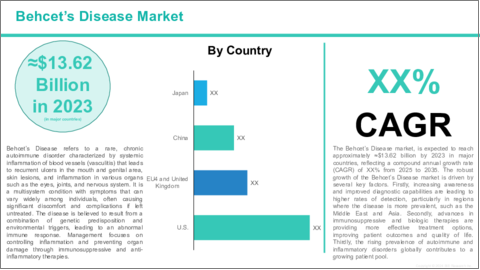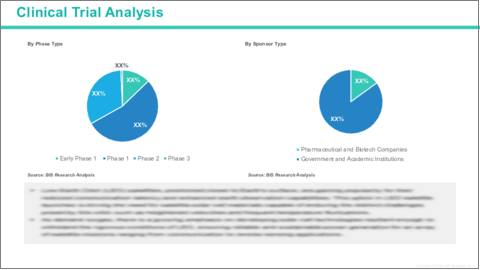|
|
市場調査レポート
商品コード
1749757
ベーチェット病市場- 世界および地域別分析:流通チャネル別、投与経路別、タイプ別、国別、地域別 - 分析と予測(2025年~2035年)Behcet's Disease Market - A Global and Regional Analysis: Focus on Distribution Channel, Route of Administration, Type, Country, and Region - Analysis and Forecast, 2025-2035 |
||||||
カスタマイズ可能
|
|||||||
| ベーチェット病市場- 世界および地域別分析:流通チャネル別、投与経路別、タイプ別、国別、地域別 - 分析と予測(2025年~2035年) |
|
出版日: 2025年06月18日
発行: BIS Research
ページ情報: 英文 120 Pages
納期: 1~5営業日
|
全表示
- 概要
- 図表
- 目次
ベーチェット病は、全身の血管の炎症(血管炎)を特徴とするまれな慢性全身性自己免疫疾患です。
痛みを伴う口内炎や性器潰瘍、皮膚病変、眼の炎症(ぶどう膜炎)などの症状が再発し、関節、神経系、血管に影響を及ぼすこともあります。ベーチェット病の正確な原因は不明ですが、遺伝的素因と免疫系が自己の組織を攻撃する環境的誘因の組み合わせから生じると考えられています。ベーチェット病は多臓器に及ぶ病変を有し、症状も多様であるため、診断は困難であり、その管理には通常、炎症を制御し合併症を予防するための集学的アプローチが必要となります。
ベーチェット病市場の主な促進要因のひとつは、特に中東、アジア、地中海沿岸などの罹患率の高い地域で、この疾患の有病率が増加し、診断が向上していることです。医療従事者の意識の向上と診断技術の進歩により早期発見が可能となり、治療を求める患者層が拡大しています。さらに、従来の治療よりも有効性と安全性が向上した標的生物学的製剤や免疫抑制剤の採用が拡大していることも、需要を後押ししています。新興市場におけるヘルスケアインフラの拡大や専門医療へのアクセスの向上も市場の成長に寄与しており、ベーチェット病の効果的な管理が世界的に利用しやすくなっています。
ベーチェット病市場の成長にもかかわらず、いくつかの課題がその潜在的可能性を妨げています。1つの大きな課題は、この疾患の複雑性と多様性であり、多臓器に及ぶ病変と決定的なバイオマーカーの欠如により診断が困難です。このため、治療開始が遅れ、一貫性のない管理アプローチがとられることが多いです。さらに、生物学的製剤や免疫抑制剤は高価であるため、特に中低所得国では治療へのアクセスが限られています。疾患特異的に承認された治療法が限られているため、適応外使用に頼らざるを得ず、最適な治療結果が得られない可能性があります。さらに、ベーチェット病は慢性疾患であるため、長期にわたる治療が必要であり、患者のアドヒアランスや潜在的な副作用が懸念されます。規制上のハードルや地域間のヘルスケアインフラの格差もまた、市場拡大や公平な患者ケアの大きな障壁となっています。ベーチェット病の成長を維持し、治療成績を向上させるためには、これらの課題に対処することが不可欠です。
世界のベーチェット病市場は、治療開発と患者ケアの革新を推進する複数の主要企業の存在によって特徴づけられる、非常に競争の激しい市場です。AbbVie Inc.、Novartis AG、F. Hoffmann-La Roche Ltd.、Johnson &Johnson(Janssen Korea Ltd.)、Bristol-Myers Squibb Companyなどの主要企業は、特に生物学的製剤や標的免疫調節療法において、治療の選択肢を広げる最前線に立っています。さらに、GlaxoSmithKline plc、Amgen Inc.、Eisai Co., Ltd.などの企業が、新薬候補やドラッグデリバリー方法の改良に焦点を当てた研究開発に貢献しています。また、Ganzhou Hemay Pharmaceutical Co., Ltd.やSanguine Biosciences, Inc.などの新興企業は、未充足のニーズに対応するための新たな視点と革新的なアプローチをもたらしています。この競合情勢は、急速な技術革新、共同研究、治療法の多様化を促進し、ベーチェット病管理における全体的な患者の転帰を向上させ、市場機会を拡大しています。
市場セグメンテーション:
セグメンテーション1:タイプ別
- 神経ベーチェット病
- 眼性ベーチェット病
- 血管ベーチェット病
セグメンテーション2:投与経路別
- 経口
- 静脈内投与
- その他
セグメンテーション3:流通チャネル別
- 病院薬局
- 小売薬局
- オンライン薬局
セグメンテーション4:地域別
- 北米
- 欧州
- アジア太平洋
- その他の地域
世界のベーチェット病市場は、診断と治療の展望を再構築するいくつかの重要な新たな動向を経験しています。顕著な動向のひとつは、TNF阻害剤やインターロイキンブロッカーなどの標的生物学的製剤の使用が増加していることであり、従来の免疫抑制剤と比較して副作用が少なく、より正確で効果的な炎症管理が可能です。
さらに、遺伝子やバイオマーカー研究の進歩により、より早期かつ正確な診断が可能になり、個々の患者のプロファイルに合わせた個別化治療計画が立てやすくなっています。遠隔医療や遠隔患者モニタリングを含むデジタルヘルス技術の統合は、疾病管理と患者のアドヒアランスを向上させています。さらに、ベーチェット病の多臓器にまたがる性質に対応する集学的治療アプローチが注目されるようになり、患者の転帰全体が改善されつつあります。これらの動向はベーチェット病市場における技術革新を促進し、治療の質を向上させています。
当レポートでは、世界のベーチェット病市場について調査し、市場の概要とともに、流通チャネル別、投与経路別、タイプ別、国別、地域別の動向、および市場に参入する企業のプロファイルなどを提供しています。
目次
エグゼクティブサマリー
第1章 世界のベーチェット病市場:業界展望
- イントロダクション
- 市場動向
- 規制の枠組み
- 疫学分析
- 臨床試験分析
- 市場力学
第2章 世界のベーチェット病市場(流通チャネル別)、2023年~2035年
- オンライン薬局
- 病院薬局
- 小売薬局
第3章 世界のベーチェット病市場(タイプ別)、2023年~2035年
- 神経ベーチェット病
- 眼性ベーチェット病
- 血管ベーチェット病
第4章 世界のベーチェット病市場(地域別)、2023年~2035年
- 北米
- 欧州
- アジア太平洋
第5章 世界のベーチェット病市場:競合情勢と企業プロファイル
- 主要戦略と開発
- 合併と買収
- 相乗効果のある活動
- 事業拡大と資金調達
- 製品の発売と承認
- その他の活動
- 企業プロファイル
- AbbVie Inc.
- Eisai Co., Ltd.
- Amgen Inc.
- Ganzhou Hemay Pharmaceutical Co., Ltd.
- Johnson & Johnson (Janssen Korea Ltd.)
- Bristol-Myers Squibb Company
- F. Hoffmann-La Roche Ltd
- Novartis AG
- GlaxoSmithKline plc
- Sanguine Biosciences, Inc.
第6章 調査手法
List of Figures
- Figure 1: Global Behcet's Disease Market (by Region), $Billion, 2024 and 2035
- Figure 2: Global Behcet's Disease Market Key Trends, Analysis
List of Tables
- Table 1: Global Behcet's Disease Market Dynamics, Impact Analysis
- Table 2: Global Behcet's Disease Market (by Region), $Billion, 2024-2035
Global Behcet's Disease Market, Analysis and Forecast: 2025-2035
Behcet's disease is a rare, chronic, and systemic autoimmune disorder characterized by inflammation of blood vessels (vasculitis) throughout the body. It leads to recurrent symptoms such as painful mouth and genital ulcers, skin lesions, eye inflammation (uveitis), and may affect joints, the nervous system, and blood vessels. The exact cause of Behcet's disease is unknown, but it is believed to result from a combination of genetic predisposition and environmental triggers that cause the immune system to attack the body's own tissues. Due to its multisystem involvement and variable symptoms, diagnosis can be challenging, and management typically requires a multidisciplinary approach to control inflammation and prevent complications.
One of the key drivers of the Behcet's disease market is the increasing prevalence and improved diagnosis of the disease, particularly in regions with higher incidence such as the Middle East, Asia, and the Mediterranean. Enhanced awareness among healthcare professionals and advancements in diagnostic techniques have led to earlier detection, expanding the patient population seeking treatment. Additionally, the growing adoption of targeted biologic therapies and immunosuppressive agents, which offer improved efficacy and safety over traditional treatments, is driving demand. Expanding healthcare infrastructure and increased access to specialty care in emerging markets further contribute to market growth, making effective management of Behcet's disease more accessible globally.
Despite the growth of the Behcet's disease market, several challenges continue to impede its full potential. One major challenge is the complexity and variability of the disease, which makes diagnosis difficult due to its multisystem involvement and lack of definitive biomarkers. This often leads to delayed treatment initiation and inconsistent management approaches. Additionally, the high cost of biologic therapies and immunosuppressive drugs limits accessibility, especially in low- and middle-income countries. The limited availability of disease-specific approved treatments forces reliance on off-label use of medications, which may not provide optimal outcomes. Furthermore, the chronic nature of Behcet's disease requires long-term therapy, raising concerns about patient adherence and potential side effects. Regulatory hurdles and disparities in healthcare infrastructure across regions also pose significant barriers to market expansion and equitable patient care. Addressing these challenges is essential for sustaining growth and improving therapeutic outcomes in Behcet's disease.
The global Behcet's disease market is highly competitive, characterized by the presence of several key players driving innovation in therapeutic development and patient care. Leading pharmaceutical companies such as AbbVie Inc., Novartis AG, F. Hoffmann-La Roche Ltd, Johnson & Johnson (Janssen Korea Ltd.), and Bristol-Myers Squibb Company are at the forefront of advancing treatment options, particularly with biologics and targeted immunomodulatory therapies. Additionally, companies such as GlaxoSmithKline plc, Amgen Inc., and Eisai Co., Ltd. contribute to research, and development efforts focused on novel drug candidates and improved delivery methods. Emerging firms such as Ganzhou Hemay Pharmaceutical Co., Ltd. and Sanguine Biosciences, Inc. bring fresh perspectives and innovative approaches to address unmet needs. This competitive landscape fosters rapid innovation, collaboration, and diversification of treatment modalities, enhancing overall patient outcomes and expanding market opportunities in Behcet's disease management.
Market Segmentation:
Segmentation 1: by Type
- Neuro-Behcet
- Ocular-Behcet
- Vasculo-Behcet
Segmentation 2: by Route of Administration
- Oral
- Intravenous
- Other
Segmentation 3: by Distribution Channel
- Hospital Pharmacy
- Retail Pharmacy
- Online Pharmacy
Segmentation 4: by Region
- North America
- Europe
- Asia-Pacific
- Rest of the World
The global Behcet's disease market is experiencing several key emerging trends that are reshaping the landscape of diagnosis and treatment. One prominent trend is the increasing use of targeted biologic therapies, such as TNF inhibitors and interleukin blockers, which offer more precise and effective management of inflammation with fewer side effects compared to traditional immunosuppressants.
Additionally, advances in genetic and biomarker research are enabling earlier and more accurate diagnosis, facilitating personalized treatment plans tailored to individual patient profiles. The integration of digital health technologies, including telemedicine and remote patient monitoring, is improving disease management and patient adherence. Moreover, there is a growing focus on multidisciplinary care approaches that address the multisystem nature of Behcet's disease, enhancing overall patient outcomes. These trends collectively are driving innovation and improving the quality of care in the Behcet's disease market.
Table of Contents
Executive Summary
Scope and Definition
Market/Product Definition
Inclusion and Exclusion
Key Questions Answered
Analysis and Forecast Note
1. Global Behcet's Disease Market: Industry Outlook
- 1.1 Introduction
- 1.2 Market Trends
- 1.3 Regulatory Framework
- 1.4 Epidemiology Analysis
- 1.5 Clinical Trial Analysis
- 1.6 Market Dynamics
- 1.6.1 Impact Analysis
- 1.6.2 Market Drivers
- 1.6.3 Market Challenges
- 1.6.4 Market Opportunities
2. Global Behcet's Disease Market (Distribution Channel), ($Billion), 2023-2035
- 2.1 Online Pharmacy
- 2.2 Hospital Pharmacy
- 2.3 Retail Pharmacy
3. Global Behcet's Disease Market (Type), ($Billion), 2023-2035
- 3.1 Neuro-Behcet
- 3.2 Ocular-Behcet
- 3.3 Vasculo-Behcet
4. Global Behcet's Disease Market (Region), ($Billion), 2023-2035
- 4.1 North America
- 4.1.1 Key Findings
- 4.1.2 Market Dynamics
- 4.1.3 Market Sizing and Forecast
- 4.1.3.1 North America Behcet's Disease Market, by Country
- 4.1.3.1.1 U.S.
- 4.1.3.1 North America Behcet's Disease Market, by Country
- 4.2 Europe
- 4.2.1 Key Findings
- 4.2.2 Market Dynamics
- 4.2.3 Market Sizing and Forecast
- 4.2.3.1 Europe Behcet's Disease Market, by Country
- 4.2.3.1.1 Germany
- 4.2.3.1.2 U.K.
- 4.2.3.1.3 France
- 4.2.3.1.4 Italy
- 4.2.3.1 Europe Behcet's Disease Market, by Country
- 4.3 Asia Pacific
- 4.3.1 Key Findings
- 4.3.2 Market Dynamics
- 4.3.3 Market Sizing and Forecast
- 4.3.3.1 Asia Pacific Behcet's Disease Market, by Country
- 4.3.3.1.1 China
- 4.3.3.1.2 Japan
- 4.3.3.1 Asia Pacific Behcet's Disease Market, by Country
5. Global Behcet's Disease Market: Competitive Landscape and Company Profiles
- 5.1 Key Strategies and Development
- 5.1.1 Mergers and Acquisitions
- 5.1.2 Synergistic Activities
- 5.1.3 Business Expansions and Funding
- 5.1.4 Product Launches and Approvals
- 5.1.5 Other Activities
- 5.2 Company Profiles
- 5.2.1 AbbVie Inc.
- 5.2.1.1 Overview
- 5.2.1.2 Top Products / Product Portfolio
- 5.2.1.3 Top Competitors
- 5.2.1.4 Target Customers/End-Users
- 5.2.1.5 Key Personnel
- 5.2.1.6 Analyst View
- 5.2.2 Eisai Co., Ltd.
- 5.2.2.1 Overview
- 5.2.2.2 Top Products / Product Portfolio
- 5.2.2.3 Top Competitors
- 5.2.2.4 Target Customers/End-Users
- 5.2.2.5 Key Personnel
- 5.2.2.6 Analyst View
- 5.2.3 Amgen Inc.
- 5.2.3.1 Overview
- 5.2.3.2 Top Products / Product Portfolio
- 5.2.3.3 Top Competitors
- 5.2.3.4 Target Customers/End-Users
- 5.2.3.5 Key Personnel
- 5.2.3.6 Analyst View
- 5.2.4 Ganzhou Hemay Pharmaceutical Co., Ltd.
- 5.2.4.1 Overview
- 5.2.4.2 Top Products / Product Portfolio
- 5.2.4.3 Top Competitors
- 5.2.4.4 Target Customers/End-Users
- 5.2.4.5 Key Personnel
- 5.2.4.6 Analyst View
- 5.2.5 Johnson & Johnson (Janssen Korea Ltd.)
- 5.2.5.1 Overview
- 5.2.5.2 Top Products / Product Portfolio
- 5.2.5.3 Top Competitors
- 5.2.5.4 Target Customers/End-Users
- 5.2.5.5 Key Personnel
- 5.2.5.6 Analyst View
- 5.2.6 Bristol-Myers Squibb Company
- 5.2.6.1 Overview
- 5.2.6.2 Top Products / Product Portfolio
- 5.2.6.3 Top Competitors
- 5.2.6.4 Target Customers/End-Users
- 5.2.6.5 Key Personnel
- 5.2.6.6 Analyst View
- 5.2.7 F. Hoffmann-La Roche Ltd
- 5.2.7.1 Overview
- 5.2.7.2 Top Products / Product Portfolio
- 5.2.7.3 Top Competitors
- 5.2.7.4 Target Customers/End-Users
- 5.2.7.5 Key Personnel
- 5.2.7.6 Analyst View
- 5.2.8 Novartis AG
- 5.2.8.1 Overview
- 5.2.8.2 Top Products / Product Portfolio
- 5.2.8.3 Top Competitors
- 5.2.8.4 Target Customers/End-Users
- 5.2.8.5 Key Personnel
- 5.2.8.6 Analyst View
- 5.2.9 GlaxoSmithKline plc
- 5.2.9.1 Overview
- 5.2.9.2 Top Products / Product Portfolio
- 5.2.9.3 Top Competitors
- 5.2.9.4 Target Customers/End-Users
- 5.2.9.5 Key Personnel
- 5.2.9.6 Analyst View
- 5.2.10 Sanguine Biosciences, Inc.
- 5.2.10.1 Overview
- 5.2.10.2 Top Products / Product Portfolio
- 5.2.10.3 Top Competitors
- 5.2.10.4 Target Customers/End-Users
- 5.2.10.5 Key Personnel
- 5.2.10.6 Analyst View
- 5.2.1 AbbVie Inc.





